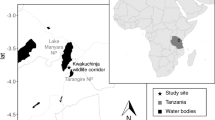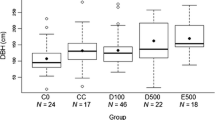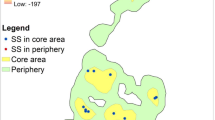Abstract
Wild primates can spend up to half of their lives sleeping, during which time they are subjected to many of the same selective pressures that they face when awake. Choosing an appropriate sleeping site can thus have important fitness consequences. We examined the sleeping site preferences of wild hooded capuchins (Sapajus cay) in a small degraded fragment of the Upper Paraná Atlantic Forest at Rancho Laguna Blanca (RLB) in eastern Paraguay. Sleeping trees and sites were identified during 5 months of field observations and their physical characteristics were compared to those of non-sleeping trees and sites. Capuchins preferred larger emergent trees with more main and forked branches, no lianas and denser undergrowth directly below. These were found in sites of more mature forest with fewer small trees, less liana coverage and denser undergrowth but more fruiting trees. The species composition of the sleeping sites differed from that of the non-sleeping sites and was dominated by Albizia niopoides (Mimosaceae) as well as Peltophorum dubium (Fabaceae) and Anadenanthera colubrina (Fabaceae). The capuchins were found to sleep most often in these three tree species: 69.23% in Albizia niopoides (Mimosaceae), 11.54% in Peltophorum dubium (Fabaceae) and 11.54% in Anadenanthera colubrina (Fabaceae). We found evidence for the predator avoidance, thermoregulatory, social contact and feeding site proximity hypotheses. We found no support for parasite avoidance, given the reuse of sites, although the small size of the forest fragment may have restricted this. Their preference for older-growth forest suggests that selective logging impacts hooded capuchins. However, their persistence in a disturbed fragment shows they are highly adaptable, providing support for the value of conservation and reforestation of even small fragments of the Paraguayan Upper Paraná Atlantic Forest.


Similar content being viewed by others
References
Albert A, Savini T, Huynen MC (2011) Sleeping site selection and presleep behavior in wild pig-tailed macaques. Am J Primatol 73:1222–1230
Altmann J (1974) Observational study of behavior: sampling methods. Behaviour 49:227–267
Anderson JR (1984) Ethology and ecology of sleep in monkeys and apes. Adv Stud Behav 14:156–229
Anderson JR (1998) Sleep, sleeping sites, and sleep-related activities: awakening to their significance. Am J Primatol 46:63–75
Barnett AA, Shaw P, Spironello WR, MacLarnon A, Ross C (2012) Sleeping sites selection by golden-backed uacaris, Cacajao melanocephalus ouakary (Pitheciidae), in Amazonian flooded forests. Primates 53:273–285
Bernard H, Matsuda I, Hanya G, Ahmad AH (2011) Characteristics of night sleeping trees of proboscis monkeys (Nasalis larvatus) in Sabah, Malaysia. Int J Primatol 32:259–267
Brotcorne F, Maslarov C, Wandia IN, Fuentes A, Beugels-Jamar RC, Huynen MC (2014) The role of anthropic, ecological and social factors in sleeping site choice by long-tailed macaques (Macaca fascicularis). Am J Primatol 76:1140–1150
Chapman CA (1986) Boa constrictor predation and group response in white-faced Cebus monkeys. Biotropica 18:171–177
Chapman CA (1989) Spider monkey sleeping sites: use and availability. Am J Primatol 18:53–60
Chapman CA, Peres CA (2001) Primate conservation in the new millennium: the role of scientists. Evol Anthropol 10:16–33
Chinchilla M, Urbani B, Valerio I, Vanegas JC (2010) Parasitosis intestinal en Monos Capuchinos Cariblancos (Cebus capucinus) (Primates: cebidae) de un Área Protegida en la Provincia de Lima en Noreste de Costa Rica. Rev Biol Trop 58:1335–1346
Crook JH, Aldrich-Blake P (1968) Ecological and behavioural contrasts between sympatric ground dwelling primates in Ethiopia. Folia Primatol 8:192–227
Cui LW, Quan R-C, Xiao W (2006) Sleeping sites of black and white snub-nosed monkeys (Rhinopithecus bieti) at Baima Snow Mountain, China. J Zool 270:192–198
Day RT, Elwood RW (1999) Sleeping site selection by the golden-handed tamarin (Saguinus midas midas): the role of predation risks, proximity to feeding sites, and territorial defense. Ethology 105:1035–1051
Di Bitetti MS, Vidal EML, Baldovino MC, Benesovsky V (2000) Sleeping site preferences in tufted capuchin monkeys (Cebus apella nigritus). Am J Primatol 50:257–274
Fan PF, Jiang XL (2008) Sleeping sites, sleeping trees, and sleep-related behaviors of black-crested gibbons (Nomascus concolor jingdongensis) at Mount Wuliang, Central Yunnan, China. Am J Primatol 70:153–160
Fei HL, Scott MB, Zhang W, Ma CY, Xiang ZF (2012) Sleeping tree selection of cao vit gibbon (Nomascus nasutus) living in degraded Karst Forest in Bangliang, Jingxi, China. Am J Primatol 74:998–1005
Feilen KL, Marshall AJ (2014) Sleeping site selection by proboscis monkeys (Nasalis larvatus) in West Kalimantan, Indonesia. Am J Primatol 76:1127–1139
Fernandes O Jr (2013) Comportamento Alimentar de um Grupo de Macacos Prego Sapajus cay (Illiger, 1815) (Primates, Cebidae), em Fragmento de Cerrado, Guia Lopes da Laguna, Mato Grosso do Sul. Dissertacão de Mestrado. Universidade Federal de Mato Grosso do Sul, Mato Grosso do Sul
Fragaszy DM, Visalberghi E, Fedigan LM (2004) The complete capuchin: the biology of the genus Cebus. Cambridge University Press, Cambridge
Ganzhorn JU, Rakotondranary SJ, Ratovonamana YR (2011) Habitat description and phenology. In: Setchell JM, Curtis JD (eds) Field and laboratory methods in primatology: a practical guide, 2nd edn. Cambridge University Press, Cambridge, pp 51–68
Garcia JE, Braza F (1993) Sleeping sites and lodge trees of the night monkey (Aotus azarae) in Bolivia. Int J Primatol 14:467–477
Goodall J (1962) Nest-building behaviour in the free ranging chimpanzee. Ann NY Acad Sci 102:455–568
Hankerson SJ, Franklin SP, Dietz JM (2007) Tree and forest characteristics influence sleeping site choice by golden lion tamarins. Am J Primatol 69:976–988
Heymann EW (1995) Sleeping habits of tamarins, Saguinus mystax and Saguinus fuscicollis (Mammalia, Primates, Callitrichidae), in North-Eastern Peru. J Zool 237:211–226
Hirsch BT (2002) Social monitoring and vigilance behavior in brown capuchin monkeys (Cebus apella). Behav Ecol Sociobiol 52:458–464
Holmes TD, Bergstrom ML, Fedigan LM (2011) Sleeping site selection by white-faced capuchins (Cebus capucinus) in the Área de Conservación Guanacaste, Costa Rica. Ecol Environ Anthropol 6:1–9
Hrdy S (1977) The langurs of Abu: female and male strategies of reproduction. Harvard University Press, Cambridge
Huang C, Kim S, Altstatt A, Townshend JRG, Davis P, Song K, Rodas O, Yanosky A, Clay R, Musinsky J (2007) Rapid loss of Paraguay’s Atlantic forest and the status of protected areas—a Landsat assessment. Remote Sens Environ 106:460–466
Huffman MA, Caton JM (2001) Self-induced increase of gut motility and the control of parasitic infections in wild chimpanzees. Int J Primatol 22:329–347
Illiger K (1815) Überblick der Säugthiere nach ihrer Vertheilung über die Welttheile. Abh K Akad Wiss Berlin 1804–1811:39–159
Iwamoto T, Mori A, Kawai M, Bekele A (1996) Anti-predator behaviour of gelada baboons. Primates 37:389–397
Jennings S, Brown N, Sheil D (1999) Assessing forest canopies and understory illumination: canopy closure, canopy cover and other measures. Forestry 72:59–73
Kowalewski M, Zunino GE (2005) The parasite behavior hypothesis and the use of sleeping sites by black howler monkeys (Alouatta caraya) in a discontinuous forest. Neotrop Primates 13:22–26
Li D, Ren B, Grueter CC, Li B, Li M (2010) Nocturnal sleeping habits of the Yunnan snub-nosed monkey in Xiangguging, China. Am J Primatol 72:1092–1099
Liu Z, Zhao Q (2004) Sleeping sites of Rhinopithecus bieti at Mount Fuhe, Yunnan. Primates 45:241–248
Lowen JC, Bartina L, Clay RP, Tobias JA (1996) Biological surveys and conservation priorities in Eastern Paraguay. CBS Conservation Publications, Cambridge
Lynch-Alfaro JW, Boubli JP, Olson LE, Di Fiore A, Wilson B, Gutiérrez-Espeleta GA, Chiou KI, Schulte M, Neitzel S, Ross V, Schwochow D, Nguyen MTT, Farias I, Janson CH, Alfaro ME (2012) Explosive Pleistocene range expansion leads to widespread Amazonian sympatry between robust and gracile capuchin monkeys. J Biogeogr 39:272–288
Mehlman PT, Doran DM (2002) Influencing Western gorilla nest construction at Mondika Research Center. Int J Primatol 23:1257–1285
Mendes-Pontes AR, Soares ML (2005) Sleeping sites of common marmosets (Callithrix jacchus) in defaunated urban forest fragments: a strategy to maximize food intake. J Zool 266:55–63
Parr NA, Fedigan L, Kutz SJ (2013) A coprological survey of parasites in white-faced capuchins (Cebus capucinus) from Sector Santa Rosa, ACG, Costa Rica. Folia Primatol 84:102–114
Phillips KA, Haas ME, Grafton BW, Yrivarren M (2004) Survey of the gastrointestinal parasites of the primate community at Tambopata National Reserve, Peru. J Zool 264:149–151
Phoonjampa R, Koenig A, Borries C, Gale GA, Savini T (2010) Selection of sleeping trees in pileated gibbons (Hylobates pileatus). Am J Primatol 71:1–9
Pinto MCM (2006) Padrão Comportamental de um Grupo de Macacos-Prego (Cebus apella cay Illiger, 1815) no Parque Estadual Matas do Segredo, Campo Grande. Dissertacão de Mestrado. Universidade Federal de Mato Grosso do Sul, Mato Grosso do Sul
Prasetyo D, Ancrenaz M, Morrogh-Bernard HC, Suci Utami Atmoko S, Wich SA, Wich SA, van Schaik CP (2009) Nest building in orangutans. In: Wich SA, Suci Utami Atmoko S, Mitrasetia T, van Schaik CP (eds) Orangutans: geographic variation in behavioural ecology and conservation, 1st edn. Oxford University Press, Oxford, pp 269–277
Ramakrishnan U, Coss R (2001) Strategies used by bonnet macaques (Macaca radiata) to reduce predation risk while sleeping. Primates 42:193–206
Rylands AB, Mittermeier RA, Bezerra BM, Paim RP, Queiroz HL (2013) Family Cebidae (squirrel monkeys and capuchins). In: Mittermeier RA, Rylands AB, Wilson DE (eds) Handbook of the mammals of the world, vol 3. Lynx Edicions, Barcelona, pp 348–413
Seiler M, Holderied M, Schwitzer C (2013) Effects of habitat degradation on sleeping site choice and use in Sahamalaza sportive lemurs (Lepilemur sahamalazensis). Int J Primatol 34:260–280
Seyfarth RM, Cheney DL (2010) Primate vocal communication. In: Platt M, Ghazanfar A (eds) Primate neuroethology. Oxford University Press, Oxford
Smith RL, Briggs E (2015) Using camera traps to determine group composition in a Paraguayan population of Sapajus cay. Neotrop Primates 22:81–88
Smith AC, Knogge C, Huck M, Lottker P, Buchanan-Smith HM, Heymann EW (2007) Long-term patterns of sleeping site use in wild saddleback (Saguinus fuscicollis) and mustached tamarins (S. mystax): effects of foraging, thermoregulation, predation, and resource defense constraints. Am J Phys Anthropol 134:340–353
Soini P (1988) The pygmy marmoset, genus Cebuella. In: Mittermeier RA, Rylands AB, Coimbra-Filho AF, da Fonseca GAB (eds) Ecology and behavior of neotropical primates. World Wildlife Fund, Washington, DC, pp 79–112
Stallings JR (1985) Distribution and status of primates in Paraguay. Primate Conserv 6:52–58
Tenaza RR, Tilson RL (1985) Human predation and Kloss’s gibbons (H. klossii) sleeping trees on Siberut Island, Indonesia. Am J Primatol 8:229–308
van Schaik CP (1983) Why are diurnal primates living in groups? Behaviour 88:120–143
von Hippel FA (1998) Use of sleeping trees by black and white colobus monkeys (Colobus guereza) in the Kakamega Forest, Kenya. Am J Primatol 43:281–290
Wahungu GM (2001) Common use of sleeping sites by two primate species in Tana River, Kenya. Afr J Ecol 39:18–23
Wallace RB (2015) Sapajus cay. Resource document: The IUCN red list of threatened species, version 2015.2. http://www.iucnredlist.org/details/136366/0. Accessed 24 August 2015
World Wildlife Fund (2015) Priority places, South America: Atlantic Forest. http://wwf.panda.org/what_we_do/where_we_work/atlantic_forests/. Accessed 24 Aug 2015
Zhang SY (1995) Sleeping habits of brown capuchin monkeys (Cebus apella) in French Guiana. Am J Primatol 36:327–335
Acknowledgements
Many thanks to Jorge Damian Ayala Santacruz for assistance with tree identification and measurements. Thanks to Associate Professor Michael Schwarz (Flinders University) and Professor David Lusseau (University of Aberdeen) for their advice on statistical analysis. We are grateful to all the Fundación Para La Tierra volunteers who assisted with site measurements. We are grateful to Susan Smith, Emily Briggs and Anna O’Riordan for helpful comments on earlier drafts of this paper and to Dr. Jose Rimoli and Dr. Maria Celia Baldovino for their extremely helpful advice. We thank the estate of Don Julio Contreras for their unfailing support of Fundación Para La Tierra.
Author information
Authors and Affiliations
Corresponding author
Ethics declarations
Conflict of interest
The authors state that there is no conflict of interest.
Ethical standards
Our research was approved by the Secretaria del Ambiente and complied with all local laws. The study was noninvasive and followed the American Society of Primatology Code of Best Practices for Field Primatology (2014).
About this article
Cite this article
Smith, R.L., Hayes, S.E., Smith, P. et al. Sleeping site preferences in Sapajus cay Illiger 1815 (Primates: Cebidae) in a disturbed fragment of the Upper Paraná Atlantic Forest, Rancho Laguna Blanca, Eastern Paraguay. Primates 59, 79–88 (2018). https://doi.org/10.1007/s10329-017-0626-7
Received:
Accepted:
Published:
Issue Date:
DOI: https://doi.org/10.1007/s10329-017-0626-7




